If you’ve ever fantasized about traveling to space, there’s only one watch that’s approved for space flight, and it’s the Omega Speedmaster.
- As the world tuned in to a space-flight emergency, Omega was busy saving the day.
- Omega Was Not The First Watch In Space
- The Birth of the Moon Watch Designation
- Omega In The Orbit
- Omega Works Under Extreme Conditions
- New Models in the 1960s
- The First Watch On the Moon was an Omega
- Omega & Apollo 13
- Every Astronaut Gets An Omega Speedmaster
- Special Editions and Models of the Speedmaster
- Why & Where To Buy An Omega Speedmaster
- Conclusion
A watch that’s highly prized by collectors, Omega has proven itself as one of the most famous luxury watch manufacturers in the world. In fact, they even outsell Rolex in some Asian markets and have done so for years. From classic dress watches to exceptional workhorses for professionals, Omega has developed a reputation for creating some of the world’s most respected timepieces that have even saved lives. In this article, we’ll discuss why the Speedmaster is such an important part of history, it’s relationship with the space program, and what really sets it apart from its competitors.
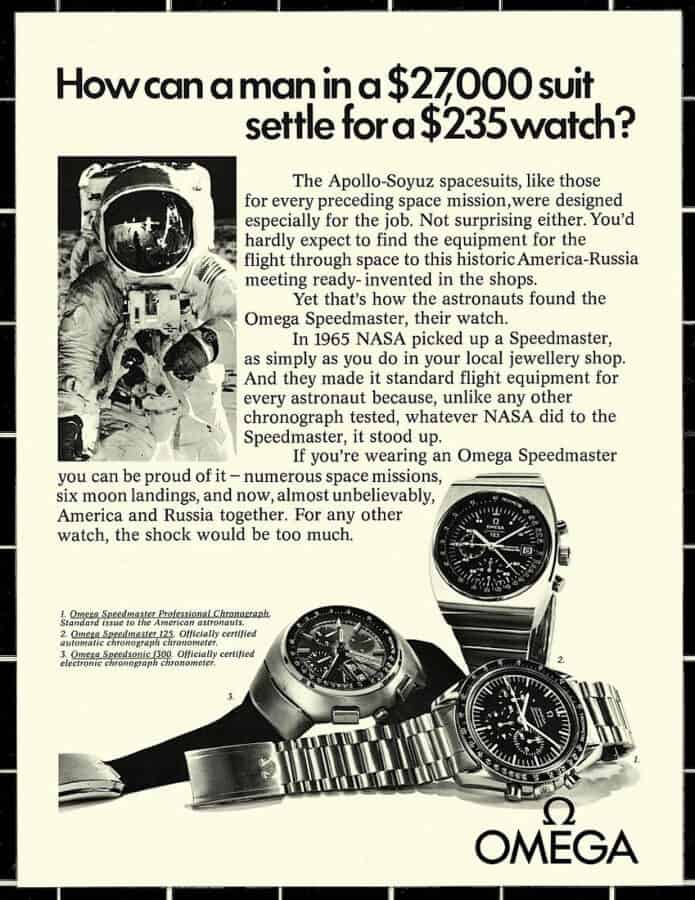
As the world tuned in to a space-flight emergency, Omega was busy saving the day.
It was April 13, 1970, just two days after the launch of Apollo 13. NASA Astronauts Fred Haise, James Lovell and John “Jack” Swigert were manning the spacecraft when a thundering bang from the silence of space was heard. The spaceship rattled and rolled violently, throwing anything that wasn’t secured to the ship. Back on Earth, NASA’s command center was about to hear the five words you pray never come over the loudspeaker.
“Houston, we have a problem.”
Like a hive of bees, the NASA space command center in Houston Texas came to life. There was a problem in the deepest depths of outer space, and NASA wasn’t convinced they could bring their boys home.

Rewind to 1968, two years before Apollo 13 lost re-entry capabilities and watchmakers in Switzerland were secretly re-designing a watch that they hoped could be approved for space travel. Little did they know that it would end up saving the lives of three heroic Astronauts who came up with a bright idea on an evening some 400,000km from Earth while passing over the dark side of the moon.
Since Astronaut Walter M. Schirra, Jr. first wore a Speedmaster when he orbited the earth on October 3, 1962, for the Mercury-Atlas 8 (MA-8) mission, Omega Speedmaster’s have been in space more than seventy times.
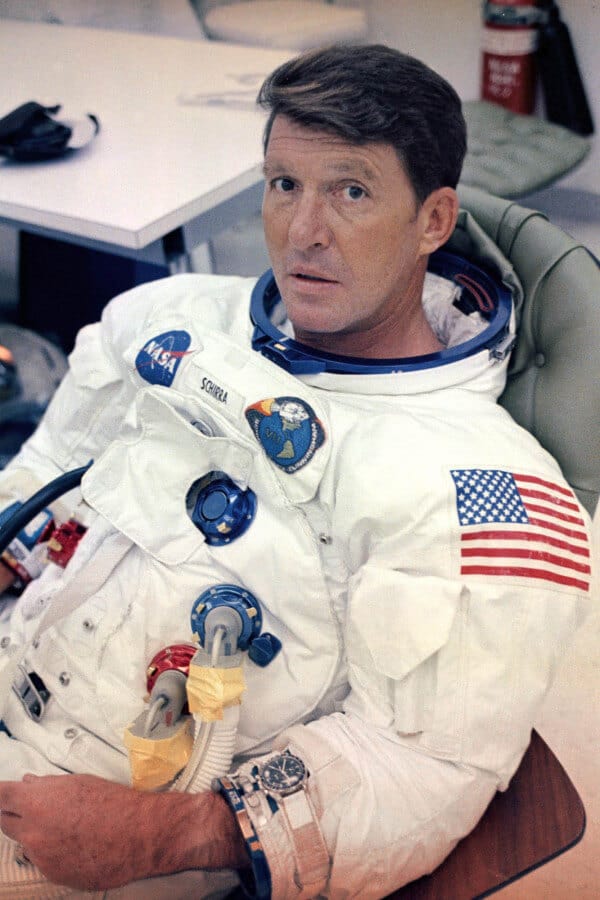
Originally designed in 1957, the Speedmaster wasn’t initially intended for use in space exploration. Instead, it aimed to be used by athletes and race car drivers for timing. Using technology developed in the early 1920s, Omega designed the Speedmaster in honor of the glory days using an engine they first started to explore in 1946 after it was created by Albert Piguet. Omega had rights to the design since Piguet’s company had been acquired by their parent company, SSIH in 1932. Due to the success of the caliber, Omega began to place it in what they would eventually call the “Speedmaster” because of the watch’s – now iconic – tachymeter scale bezel. This new model was the launch of various new complications and features such as the 12-hour, triple-register chronograph, the hésalite domed crystal made of plexiglass and the high-contrast index markers.
Omega Was Not The First Watch In Space
Prior to its official designation, there have been other watches worn in space. Despite the Omega being chosen by Schirra in 1962, the first watch to be worn in space was a Poljot, which is also known as a Sekonda or a Strela. It was worn on June 12, 1965, by Russian Cosmonaut Alexi Leonov who became the first astronaut ever to make a space walk. The watch, a mechanical two register chrono with a 45-minute totalizer and a continuously running second hand would become the official watch of the Russian space program for 20 years. It was officially retired in 1979 and succeeded by the Russian Speedmaster which lost it’s title in 1994. For the last 22 years, Fortis has been the official watch of Russian cosmonauts.
The Birth of the Moon Watch Designation
Over the next few years, new models would be introduced including the CK-2998 in 1959 which featured a black aluminum base 1000 bezel and then a second model with a tachymeter 500 bezel and alpha hands. Four years later, the Speedmaster was updated yet again with the ST 105.002 and then in just a few months, the ST 105.003 with straight baton hands instead of the previous alpha hands. Then, Omega announced its ‘Professional’ designation and released the ST 105.012 with an asymmetrical case that protected the chronograph pushers and its crown. Despite various designs, all of these watches used the same 321 engine which continued until 1968 when Omega launched it’s new caliber 861, dubbed the “Moon watch”.
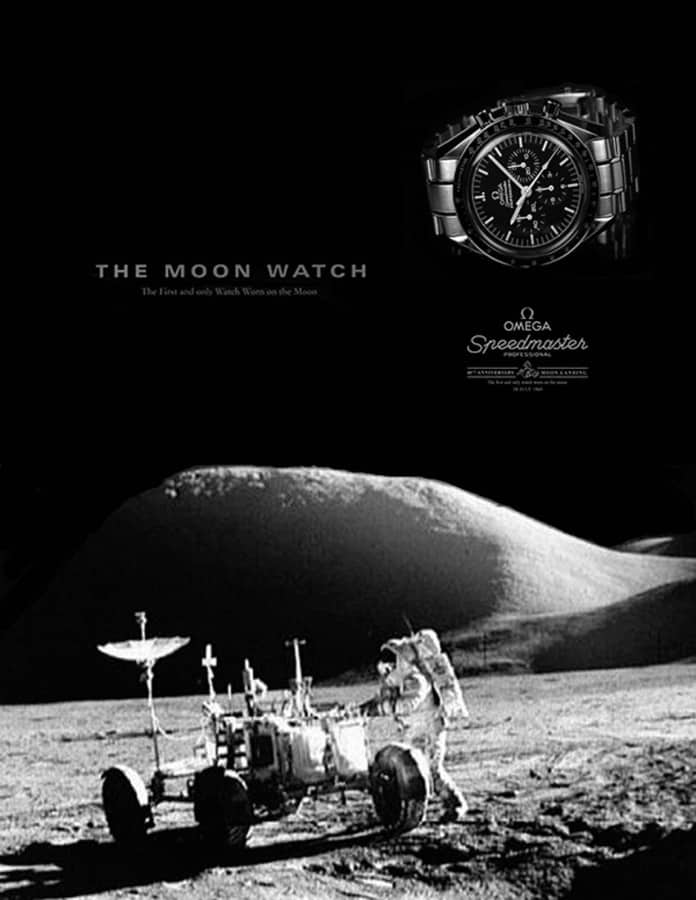
Omega In The Orbit
At the time, the Speedmaster wasn’t sanctioned as an official watch of NASA’s space program. Qualifications wouldn’t come for three more years, but Astronaut Wally Schirra made the decision to bring his personal Speedmaster with him aboard the Sigma 7 on his flight that would orbit the earth.
Omega immediately took note of this and the press went wild. Pretty soon, many Americans had seen Schirra’s watch and knew that a watch survived one of the earliest space flights. The NASA program was relatively new, and the Mercury-Atlas 8 was only its fifth manned mission. Not only did the public take note, but so did NASA. Under a cloak of secrecy, NASA purchased some commercially available chronographs from Corrigan’s, a jewelry store in Houston, Texas. The idea was to discreetly test the watches and evaluate their abilities for the upcoming Gemini and Apollo mission programs. As NASA began testing them, astronauts in the program started to recommend various watches from brands they liked. NASA decided that it needed to begin officially testing products and solicited bids from some of the world’s foremost watchmakers including Breitling, Rolex, Omega, Hamilton, and Longines-Wittnauer. However, Hamilton submitted a pocket watch instead of a wristwatch and was immediately disqualified.
Omega Works Under Extreme Conditions
Testing began to take place and lasted for approximately three years. All of the watches tested were subjected to the same scrutiny and tests which were done under what NASA has referred to as extreme conditions.
- High Temperature: 48 hours at 160 °F (71 °C) followed by 30 minutes at 200 °F (93 °C)
- Low temperature: Four hours at 0 °F (−18 °C)
- Temperature cycling in near-vacuum: Fifteen cycles of heating to 160 °F (71 °C) for 45 minutes, followed by cooling to 0 °F (−18 °C) for 45 minutes at 10−6 atm
- Humidity: 250 hours at temperatures between 68 °F (20 °C) and 160 °F (71 °C) at relative humidity of 95%
- Oxygen environment: 100% oxygen at 0.35 atm and 71 °C for 48 hours
- Shock: Six 11ms 40 g shocks from different directions
- Linear acceleration: from 1 to 7.25 g within 333 seconds
Low pressure: 90 minutes at 10−6 atm at 160 °F (71 °C) followed by 30 minutes at 200 °F (93 °C) - High pressure: 1.6 atm for one hour
- Vibration: three cycles of 30 minutes vibration varying from 5 to 2000 Hz with minimum 8.8 g impulse
- Acoustic noise: 30 minutes at 130 dB from 40 to 10,000 Hz

To qualify, all the watches had to be mechanical chronographs as neither quartz or automatic movements were available on the market until 1969. However, even when they did become available, NASA falsely believed they wouldn’t be capable of working in space. After years of testing, NASA made its decision in March of 1965 after it was determined that only one of the watches was capable of passing every test administered: the Omega Speedmaster.
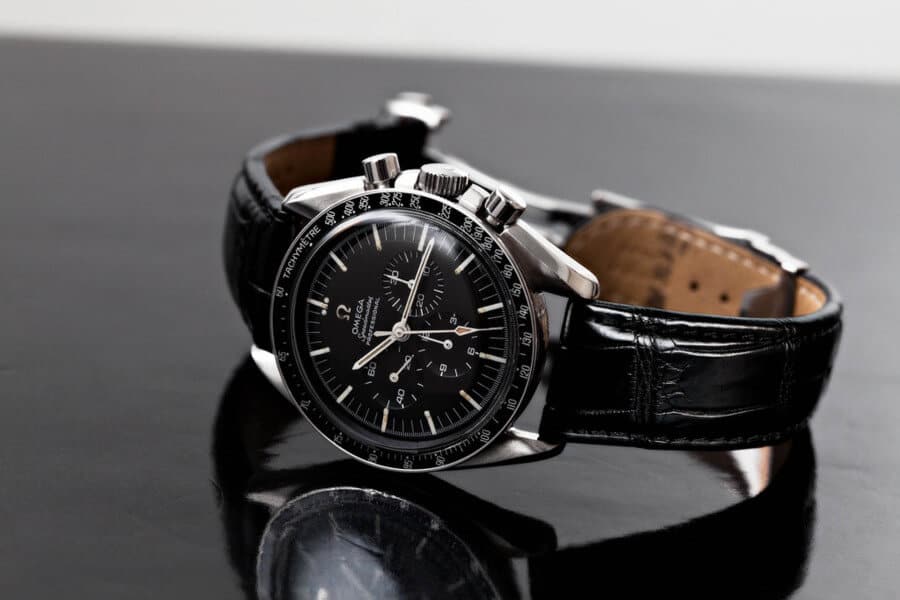
– Cal 321 manual mechanical chronometer
– Di-Modell Alligator strap
– Omega Deployant
New Models in the 1960s
When Omega was presented with the award from NASA in 1965, it immediately began working on new models. Within the same month of its designation, NASA astronauts Gus Grissom and John Young were given Speedmasters which they wore aboard Gemini 3. Less than a year later, Ed White became the first American astronaut to leave the safety of the craft and perform a spacewalk with the Omega Speedmaster strapped to the left sleeve of his G4C space suit. Since space suits were quite bulky, astronauts had to remove the factory strap and use a long nylon strap that would be wrapped around the sleeve until it was tight and secured with Velcro.

When presented with the news that the Omega Speedmaster survived a spacewalk, staff at Omega were taken aback as they had never realized it was intended to be worn outside the ship. NASA presented a photograph to Omega’s U.S. offices, and that image has been used in countless advertisements since. Following the success of the EVA, NASA began to issue Speedmasters to all subsequent crew members of the Gemini program until the program was retired in.
The First Watch On the Moon was an Omega
With the close of one space program and the launch of the Apollo program, Omega decided to introduce a new reference called the 145.012 in its honor. This reference, in conjunction with the previous 105.102 were known as the official “moon watches” and would be seen on the wrist of almost ever astronaut in the Apollo program including the famed image of Buzz Aldrin and Neil Armstrong wearing the watch. The reason that these two models were known as the “moon watches” is because they became the first watches to ever be worn on the moon. Subsequently, all Speedmasters would be inscribed with the iconic “The First Watch Worn on the Moon” tagline.
“It was optional to wear while we were walking on the surface of the moon… few things are less necessary when walking around on the moon than knowing what time it is in Houston, Texas. Nonetheless, being a watch guy, I decided to strap the Speedmaster onto my right wrist around the outside of my bulky spacesuit.”
Apollo 11 astronaut Buzz Aldrin
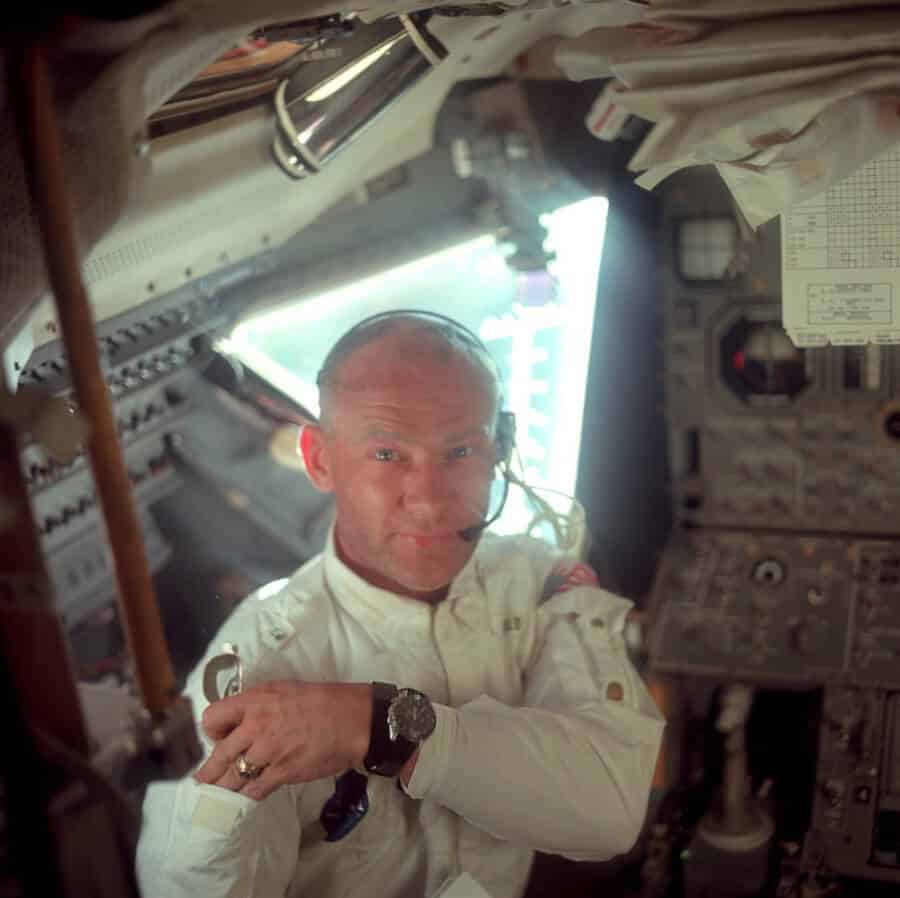
Despite his commander, Neil Armstrong, being the first man to set foot on the moon, Armstrong left his Speedmaster in the Lunar Module as a backup because the electronic timer had malfunctioned. It was the watch on Buzz Aldrin’s wrist that was the first one to be worn outside the module. Sadly, the watch was reported as missing when it disappeared while en route to the Smithsonian Institute. It has never been seen again.

Omega & Apollo 13
Now we come back to where we began and Apollo 13 is on the world stage. Americans became glued to the television waiting for updates as experts on the ground at NASA’s headquarters began contemplating options to bring their astronauts home. It turned out that the Service Module’s oxygen tank had ruptured following an electrical short that caused arcing. As the oxygen was filtered out into its hold, another tank became damaged. Since there is no oxygen in space, the only way for the astronauts on board to survive is with the oxygen in the ship’s tanks. Ground control realized the only way to prevent certain death, was if the crew powered down all nonessential systems on the ship.
It was the only way to prevent what NASA refers to as a Total Mission Failure. The problem they now faced was that the control system that was responsible for timing the mission-critical 14-second Mid-Course Correction burn was considered a nonessential system. To get back to Earth, NASA space crafts have to be able to accurately align themselves in order to be able to re-enter the Earth’s atmosphere. Even the slightest error can cause the ship to misalign meaning the craft won’t be heading in the right direction, and the astronauts on board would face certain death after being stranded in space. Opting to use the lunar module instead of the command module descent engine would greatly increase the risk of misalignment since it doesn’t have the ability to adjust for guidance automatically or optically. This meant that somehow, the astronauts had to make a mid-flight adjustment to the ship’s trajectory, and they had to precisely time it to prevent being permanently stranded in outer space.

With a lack of resources, they decided the best option was to use the chronograph on their Speedmaster watches to time the mid-flight adjustment. Trusting the manual watch on Swigert’s wrist, the crew made three precise corrections. Not only did it result in the module reentering the Earth’s atmosphere, but it did so with such precision that they landed within miles of the recovery crew that was waiting in the Pacific Ocean. In recognition of this, Omega received the prestigious Snoopy Award “for dedication, professionalism, and outstanding contributions in support of the first United States Manned Lunar Landing Project.”

Every Astronaut Gets An Omega Speedmaster
Since then, Omega Speedmaster’s have been issued to every employee in the NASA Astronaut program. In addition to the Omega Speedmaster, astronauts are allowed to bring a second watch of their choice on space flights, and many brands have seen the depths of the final frontier. One brand that has repeatedly been chosen is Sinn, which seems to be popular with pilots around the world. Other watches that have received notable attention relating to space exploration include Bulova, which was the first non-Omega watch worn during an EVA after Apollo 15’s commander David Scott, lost the plexiglass crystal of his Speedmaster during the EVA-2.
For his final lunar surface EVA, he wore his personal watch, a Bulova Chronograph 88510/01 with a velcro strap. This space walk with the Bulova remained a tight-lipped secret of NASA’s for many years due to their relationship with Omega and information wasn’t released until just recently. Prior to this incident on Apollo 15, astronauts on both the Apollo 13 and 14 missions wore Rolex GMT’s as their back-ups. Despite Omega’s claim that they are the only watch ever worn on missions to the moon.
Special Editions and Models of the Speedmaster
Since the success of the space program, Omega has released a fairly significant number of commemorative and limited edition Speedmasters in recognition of their successful partnership with NASA. Most of the moon watch designs will feature the dates of special events with the mission patch emblazoned on it. Also, Omega hasn’t forgotten its history with automotive racing and continues to produce Speedmasters in various racing color schemes. There is a wide selection of models released for the luxury watch industry in precious metals and embellished with diamonds or other gems. While the actual mechanics of the watch remain much the same, Omega has developed new complications and features to compliment its line of Speedmasters.
These include the shrouded lugs and flat, anti-reflective mineral glass on the Speedmaster Professional MKII, which was released in 1969 and the change from a black to a white dial for its Alaska Project in partnership with Pierre Chopard. This particular timepiece is also designed to function under more extreme temperature changes. Then, in 1971 and 1973, Omega launched the Automatic MKIII and MKIV alongside its Speedsonic Electronic Chronometer Chronograph, which is also sold under the Speedmaster brand. Despite these releases, no watch produced in the Speedmaster line has proved as popular as the traditional moon watch we call the Speedmaster Professional. Despite a new model that features a digital LCD quartz movement that has been taken on space missions by NASA to the Mir space station and on the Space Shuttle Columbia during STS-90, the original Speedmaster Professional is without question the most popular Omega Speedmaster model sold today.

Why & Where To Buy An Omega Speedmaster
Of all the timepieces ever produced, very few have such an illustrious history with the Western world. Today, we take spaceflight for granted in the sense that the whole world doesn’t tune in to watch a launch. However, in the dawn of the American space program, the world was watching and Astronauts were the cowboys of the sky. Omega played a big part of that history and not only accompanied these heroes on their adventures, but even managed to save some of their lives. For any man who requires a professional-grade chronograph, there are few that lay claim to a lineage like Omega. One of the most accurate luxury timepieces, they are almost always priced fairly and will last you a lifetime. If NASA can trust Omega watches in the depth of space, you can trust it wherever you are here on Earth.
Since Omega timepieces are so reasonably priced, yet heavily counterfeited, and buying vintage online can prove risky, we recommend buying from authorized retailers or reputable grey-market dealers.
If you are intent on trying to buy an Omega speedmaster online, consider buying it on amazon where you have a 30 day no questions asked return policy.
Amazon can be a fantastic resource for men not wanting the hassle of having to visit a store. Here are three watches worthy of your attention.
Omega Speedmaster Moonwatch Co-Axial Chronograph Dark Side of the Moon
Powered by an automatic Cal. 9300 movement, this Dark Side of the Moon Speedmaster features a pitch black ceramic oversized case measuring in at 44.25mm held on with a black calfskin leather strap. Click here if you are interested in this model.
Omega Speedmaster 57
Slightly smaller than the Dark Side of the Moon, this 57 is 41.5mm with a black dial and casual brown strap. Powered by its self-winding automatic movement, the 57 is a great nod to the first Speedmaster from 1957 with its straight lugs, understated dials and the fact it separates itself from other models with just two sub-dials instead of the iconic three. To facilitate this, Omega placed the 12-hour and 60-minute counters in the same sub-dial at the 3 o’clock marker which gives the user a comfortable and legible way of reading the chronograph. Click here to take a closer look.
Omega Speedmaster
Just because the other two recommended watches are over $5,000, doesn’t mean you have to spend that much to own an Omega Speedmaster. Take this particular watch, for example. With its stainless steel case and bracelet, it features a black PVD with tachymeter. The manual wound movement is the Omega Cal. 1861 engine and it comes in at 42mm’s which makes it perfect for the average man’s wrist. Water resistant to 165 feet, you can click here take a closer look..
If you are interested in finding a vintage Speedmaster, we suggest you take a look at our watch buying guide.
Conclusion
Omega Speedmaster’s are considered one of the most collectible timepieces in the world. They are arguably some of the finest made chronographs in the industry, and vintage Speedmaster’s can often be found at relatively reasonable prices on websites like eBay making them an ideal entry-level luxury watch.
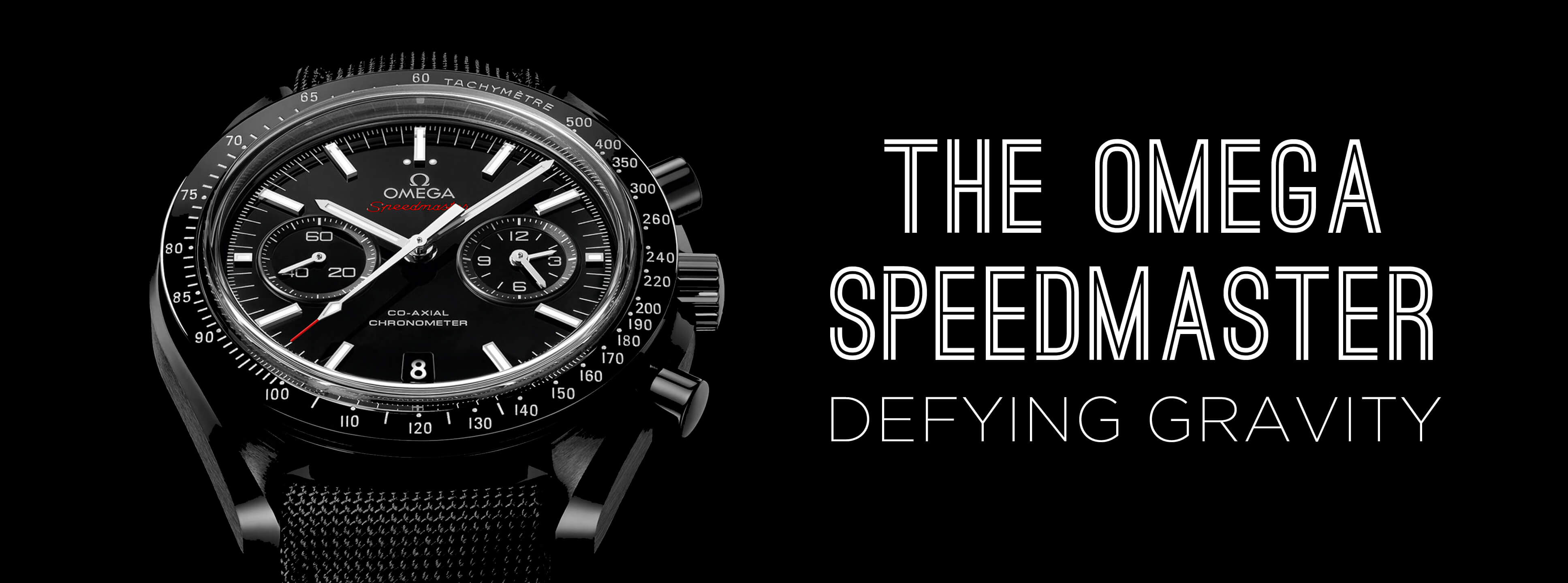


Crap! I got myself a Seamaster 300 Master Co-Axial. Oh well, at least it’s thick and heavy. Great article! :-)
Thanks!
Thank you for an excellent and informative article with superb photographs and period adverts.
I have owned my Speedmaster for around 8 years and it has performed flawlessly in all conditions.
Thank you for showcasing this great watch. I own one.
Excellent article!
I own the special edition (limited to 1957) and the Alaska project watches. Both are exquisite watches
Feel like I have been part of the Apollo journey
Dear friends, reading the article I have observed a big mistake. The wristwatch used by Jack Swigert in this picture is a Rolex GMT Master II . It can be seen very clearly the bracelet ” Oyster ” . In addition , this information is fully checked and tested in numerous articles . I am speedmaster fanatic, however we have to be serious and precise. Swigert , in addition to regular astronaut Speedmasters, used his personal rolex . Ricardo
Astronaut Jack Swigert with his Omega ? No Sir, this is a Rolex GMT Master II – confirmed even for Swigert himself !!!
I would enjoy a Speedmaster as well as the Rolex GMT II. My first watch was the Omega Seamaster and it is absolutely an amazing watch. I am glad to see this watch brand finally highlighted after all the top 50 watch articles etc that I have seen here, yet it never really included Omega. One thing I would recommend doing is buying from an authorized watch dealer regardless of brand. Most of these companies have no interest in servicing the watch that is gray market. Yes, you can typically get them serviced by a good watch repairman that knows fine time pieces. Rolex is tight on their price as they track the receipt of sale on new watches. A good way to get a good price on a Rolex is to pay the full price and negotiate the jeweler giving you store credit etc. Omega was pretty tight on their MSRP as well because if they find out the jeweler is selling it for less they can lose their inventory. I didn’t have a problem but it took a little convincing.
Side note, I recently saw the Speedmaster that Alan Sheppard wore on the Apollo 14 mission on display at the Hutchinson Cosmosphere in Kansas. They have a very nice Omega display in the lobby with the actual watch used on the mission. I would post some pictures if I could. It was a very interesting display. First thing I noticed was the enormous custom wrist strap.
Granted the Omega Speedmaster is a very cool “looking” watch, and was a relatively accurate mechanical movement for its time. But the prime purpose of any watch is accurately tracking time. And in that function it is hopelessly outdated by today’s Quartz movements. The Speedmaster was only required to be accurate to +/- 5 Seconds A Day. I owned a Bulova Accutron from about 5 years after NASA selected the Speedmaster that was accurate to within 15 Seconds A Month. I currently own an inexpensive Japanese Quartz movement I have tracked for the last two years to within 2 to 3 Seconds A Month!
Comparing the time keeping accuracy of the Omega to a modern Quartz movement is like comparing a Slide Rule to a modern Digital Calculator. And by the way all the Apollo missions clear up to Apollo 13 carried a Pickett brand Slide Rule on board.